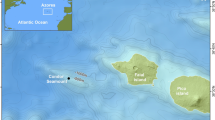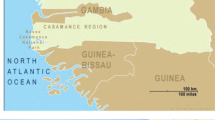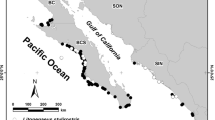Abstract
Tissue levels of mercury (Hg; total, organic) and selenium (Se) were assessed in juvenile lemon sharks (Negaprion brevirostris) from Florida nearshore waters collected during a harmful algal bloom (HAB, brevetoxin) event and compared with sharks not exposed to HABs. In all sharks studied, total Hg levels in the muscle were generally present in a molar excess over Se (which may protect against Hg toxicity) and mean muscle Hg levels (0.34 \(\upmu \)g/g) exceed safe human consumption guidelines. While there was generally no difference in tissue Hg and Se levels following exposure of sharks to HABs, hepatic Hg levels were significantly lower (56% reduction) in the HAB-exposed sharks compared to controls. As Hg and HABs are globally increasing in scope and magnitude, further work is warranted to assess their interactions and biotic impacts within aquatic ecosystems, especially for a species such as the lemon shark that is classified as a near-threatened species by the International Union for the Conservation of Nature.
Similar content being viewed by others
References
Adams, D. H., & McMichael, R. H. (1999). Mercury levels in four species of sharks from the Atlantic coast of Florida. Fishery Bulletin - NOAA, 97(2), 372–379.
Adams, D. H., McMichael, R. H., & Henderson, G. E. Jr. (2003). Mercury levels in marine and estuarine fishes of Florida 1989-2001 (Florida marine research institute technical report TR-9) (pp. 1–58). Fish and Wildlife Research Institute 100 Eighth Avenue SE St. Petersburg, Florida 33701-5020.
Allen, E. W., Prepas, E. E., Gabos, S., Strachan, W. M. J., & Zhang, W. (2005). Methyl mercury concentrations in macroinvertebrates and fish from burned and undisturbed lakes on the Boreal Plain. Canadian Journal of Fisheries and Aquatic Sciences, 62(9), 1963–1977.
Basu, N., Scheuhammer, A. M., Grochowina, N. M., Klenavic, K., Evans, R. D., O’Brien, M., et al.(2005). Effects of mercury on neurochemical receptors in wild river otters (Lontra canadensis). Environmental Science and Technology, 39(10), 3585–3591.
Berry, M. J., & Ralston, N. V. (2008). Mercury toxicity and the mitigating role of selenium. Ecohealth, 5(4), 456–459.
Bowles, K. C., Apte, S. C., Maher, W. A., Kawei, M., & Smith, R. (2001). Bioaccumulation and biomagnification of mercury in Lake Murray, Papua New Guinea. Canadian Journal of Fisheries and Aquatic Sciences, 58(5), 888–897.
Branco, V., Canario, J., Vale, C., Raimundo, J., & Reis, C. (2004). Total and organic mercury concentrations in muscle tissue of the blue shark (Prionace glauca L. 1758) from the Northeast Atlantic. Marine Pollution Bulletin, 49(9–10), 871–874.
Branco, V., Vale, C., Canario, J., & dos Santos, M. N. (2007). Mercury and selenium in blue shark (Prionace glauca, L. 1758) and swordfish (Xiphias gladius, L. 1758) from two areas of the Atlantic Ocean. Environmental Pollution, 150(3), 373–380.
Brown, C. A., & Gruber, S. H. (1988). Age assessment of the lemon shark, Negaprion brevirostris, using tetracycline validated vertebral centra. Copeia, 3, 747–753.
Cappon, C. J., & Smith, J. C. (1981). Mercury and selenium content and chemical form in fish muscle. Archives of Environmental Contamination and Toxicology, 10(3), 305–319.
Carpenter, S. R. (2008). Phosphorus control is critical to mitigating eutrophication. Proceedings of the National Academy of Sciences of the USA, 105(32), 11039–11040.
Chen, C., Yu, H., Zhao, J., Li, B., Qu, L., Liu, S., et al. (2006). The roles of serum selenium and selenoproteins on mercury toxicity in environmental and occupational exposure. Environmental Health Perspectives, 114(2), 297–301.
Childs, E. A., Gaffke, J. N., & Crawford, D. L. (1973). Exposure of dogfish shark fetus to mercury. Bulletin of Environmental Contamination and Toxicology, 9(5), 276–280.
Clarkson, T. W. (1993). Mercury: Major issues in environmental health. Environmental Health Perspectives, 100, 31–38.
Clarkson, T. W., & Magos, L. (2006). The toxicology of mercury and its chemical compounds. Critical Reviews in Toxicology, 36(8), 609–662.
Clarkson, T. W., Vyas, J. B., & Ballatorl, N. (2007). Mechanisms of mercury disposition in the body. American Journal of Industrial Medicine, 50(10), 757–764.
de Pinho, A. P., Guimaraes, J. R. D., Martins, A. S., Costa, P. A. S., Olavo, G., & Valentin, J. (2002). Total mercury in muscle tissue of five shark species from Brazilian offshore waters: Effects of feeding habit, sex, and length. Environmental Research, 89(3), 250–258.
Devries, D. R., & Frie, R. V. (1996). Determination of age and growth. In B. R. Murphy & D. W. Willis (Eds.), Fisheries techniques (2nd ed., pp. 483–512). Bethesda: ASF.
Dietz, R., Riget, F., & Born, E. W. (2000). An assessment of selenium to mercury in Greenland marine animals. Science of the Total Environment, 245(1–3), 15–24.
Essington, T. E., & Houser, J. N. (2003). The effect of whole-lake nutrient enrichment on mercury concentration in age −1 yellow perch. Transactions of the American Fisheries Society, 132(1), 57–68.
FDOH (2008). Your guide to eating fish caught in Florida (pp. 1–23). Florida Departments of Environmental Protection and Agriculture and Consumer Services, and the Florida Fish and Wildlife Conservation Commission, 2585 Merchants Row Boulevard Tallahassee, Florida 32399.
Gilmour, C. C., Henry, E. A., & Mitchell, R. (1992). Sulfate stimulation of mercury methylation in fresh-water sediments. Environmental Science and Technology, 26(11), 2281–2287.
Harris, H. H., Pickering, I. J., & George, G. N. (2003). The chemical form of mercury in fish. Science, 301(5637), 1203.
He, T., Feng, X., Guo, Y., Qiu, G., Li, Z., Liang, L., et al. (2008). The impact of eutrophication on the biogeochemical cycling of mercury species in a reservoir: A case study from Hongfeng Reservoir, Guizhou, China. Environmental Pollution, 154(1), 56–67.
Hueter, R. E., Fong, W. G., Henderson, G., French, M. F., & Manire, C. A. (1995). Methylmercury concentration in shark muscle by species, size and distribution of sharks in Florida coastal waters. Water Air and Soil Pollution, 80(1–4), 893–899.
Ikemoto, T., Kunito, T., Anan, Y., Tanaka, H., Baba, N., Miyazaki, N., et al. (2004a). Association of heavy metals with metallothionein and other proteins in hepatic cytosol of marine mammals and seabirds. Environmental Toxicology and Chemistry, 23(8), 2008–2016.
Ikemoto, T., Kunito, T., Tanaka, H., Baba, N., Miyazaki, N., & Tanabe, S. (2004b). Detoxification mechanism of heavy metals in marine mammals and seabirds: Interaction of selenium with mercury, silver, copper, zinc, and cadmium in liver. Archives of Environmental Contamination and Toxicology, 47(3), 402–413.
Kaneko, J. J., & Ralston, N. V. C. (2007). Selenium and mercury in pelagic fish in the central north pacific near Hawaii. Biological Trace Element Research, 119, 242–254.
Karouna-Renier, N. K., Ranga, R. K., Lanza, J. J., Rivers, S. D., Wilson, P. A., Hodges, D. K., et al. (2008). Mercury levels and fish consumption practices in women of child-bearing age in the Florida Panhandle. Environmental Research, 108(3), 320–326.
Kelly, C. A., Rudd, J. W. M., & Holoka, M. H. (2003). Effect of pH on mercury uptake by an aquatic bacterium: Implications for Hg cycling. Environmental Science and Technology, 37(13), 2941–2946.
Khan, M. A., & Wang, F. (2009). Mercury-selenium compounds and their toxicological significance: Toward a molecular understanding of the mercury-selenium antagonism. Environmental Toxicology and Chemistry, 28(8), 1567–1577.
Landsberg, J. H., Flewelling, L. J., & Naar, J. (2009). Karenia brevis red tides, brevetoxins in the food web, and impacts on natural resources: Decadal advancements. Harmful Algae, 8(4), 598–607.
Mason, R. P., Reinfelder, J. R., & Morel, F. M. M. (1996). Uptake, toxicity, and trophic transfer of mercury in a coastal diatom. Environmental Science and Technology, 30, 1835–1845.
McMeans, B. C., Borga, K., Bechtol, W. R., Higginbotham, D., & Fisk, A. T. (2007). Essential and non-essential element concentrations in two sleeper shark species collected in arctic waters. Environmental Pollution, 148(1), 281–290.
Mergler, D., Anderson, H. A., Chan, L. H. M., Mahaffey, K. R., & Murray, M. W. (2007). Methylmercury exposure and health effects in humans: A worldwide concern. Ambio, 36(1), 3–11.
Nigro, M., & Leonzio, C. (1996). Intracellular storage of mercury and selenium in different marine vertebrates. Marine Ecology Progress Series, 135, 137–143.
Pickhardt, P. C., & Fisher, N. S. (2007). Accumulation of inorganic and methylmercury by freshwater phytoplankton in two contrasting water bodies. Environmental Science and Technology, 41, 125–131.
Pickhardt, P. C., Folt, C. L., Chen, C. Y., Klaue, B., & Blum, J. D. (2002). Algal blooms reduce the uptake of toxic methylmercury in freshwater food webs. Proceedings of the National Academy of Sciences of the United States of America, 9(7), 4419–4423.
Ralston, N. V. C., Blackwell, J. L., & Raymond, L. J. (2007). Importance of molar ratios in selenium-dependent protection against methylmercury toxicity. Biological Trace Element Research, 119(3), 255–268.
Reyier, E. A., Adams, D. H., & Lowers, R. H. (2008). First evidence of a high density nursery ground for the lemon shark, Negaprion brevirostris, near Cape Canaveral, Florida. Florida Scientist, 71(2), 134–148.
Rudd, J. W. M., & Turner, M. A. (1983). The English-Wabigoon River system. V. Mercury and selenium bioaccumulation as a function of aquatic primary productivity. Canadian Journal of Fisheries and Aquatic Sciences, 40(12), 2251–2259.
Ruelas-Inzunza, J., & Paez-Osuna, F. (2005). Mercury in fish and shark tissues from two coastal lagoons in the gulf of California, Mexico. B. Environmental Contamination and Toxicology, 74(2), 294–300.
Scheuhammer, A. M., Meyer, M. W., Sandheinrich, M. B., & Murray, M. W. (2007). Effects of environmental methylmercury on the health of wild birds, mammals, and fish. Ambio, 36(1), 12–18.
Steidinger, K. A. (2009). Historical perspective on Karenia brevis red tide research in the Gulf of Mexico. Harmful Algae, 8(4), 549–561.
Storelli, M. M., Giacominelli-Stuffler, R., & Marcotrigiano, G. (2002). Mercury accumulation and speciation in muscle tissue of different species of sharks from Mediterranean Sea, Italy. Bulletin of Environmental Contamination and Toxicology, 68(2), 201–210.
Storelli, M. M., & Marcotrigiano, G. O. (2002). Mercury speciation and relationship between mercury and selenium in liver of Galeus melastomus from the Mediterranean Sea. Bulletin of Environmental Contamination and Toxicology, 69(4), 516–522.
Suzuki, K. T., Sasakura, C., & Yoneda, S. (1998). Binding sites for the (Hg-Se) complex on selenoprotein P. Biochemica et Biophysica Acta, 1429(1), 102–112.
Swain, E. B., Jakus, P. M., Rice, G., Lupi, F., Maxson, P. A., Pacyna, J. M., et al. (2007). Socioeconomic consequences of mercury use and pollution. Ambio, 36(1), 45–61.
Turoczy, N. J., Laurenson, L. J. B., Allinson, G., Nishikawa, M., Lambert, D. F., Smith, C., et al. (2000). Observations on metal concentrations in three species of shark (Deania calcea, Centroscymnus crepidater, and Centroscymnus owstoni) from southeastern Australian waters. Journal of Agricultural and Food Chemistry, 48(9), 4357–4364.
U.S.EPA (2001). Water Quality Criteria for the Protection of Human Health: Methylmercury. Washington, D.C. EPA-823-R-01-001.
U.S.EPA (2007). 2005/2006 National Listing of Fish Advisories. Office of Water. EPA-823-F-07-003.
Watling, R. J., Mcclurg, T. P., & Stanton, R. C. (1981). Relation between mercury concentration and size in the mako shark. Bulletin of Environmental Contamination and Toxicology, 26(3), 352–358.
Westcott, K., & Kalff, J. (1996). Environmental factors affecting methyl mercury accumulation in zooplankton. Canadian Journal of Fisheries and Aquatic Sciences, 53(10), 2221–2228.
Wolny, J., Scott, P., Brooks, C., Beadle, H., Brame, J., Browning, B., et al. (2008). Monitoring the 2007 Florida east coast Karenia brevis red tide and NSP outbreak. In 11th international conference on shellfish restoration (pp. 75–76). Charleston, SC November 19–22, 2008.
Wren, C. D., & Maccrimmon, H. R. (1983). Mercury levels in the sunfish, Lepomis-gibbosus, relative to pH and other environmental variables of Precambrian shield lakes. Canadian Journal of Fisheries and Aquatic Sciences, 40(10), 1737–1744.
Author information
Authors and Affiliations
Corresponding author
Rights and permissions
About this article
Cite this article
Nam, DH., Adams, D.H., Reyier, E.A. et al. Mercury and selenium levels in lemon sharks (Negaprion brevirostris) in relation to a harmful red tide event. Environ Monit Assess 176, 549–559 (2011). https://doi.org/10.1007/s10661-010-1603-4
Received:
Accepted:
Published:
Issue Date:
DOI: https://doi.org/10.1007/s10661-010-1603-4




